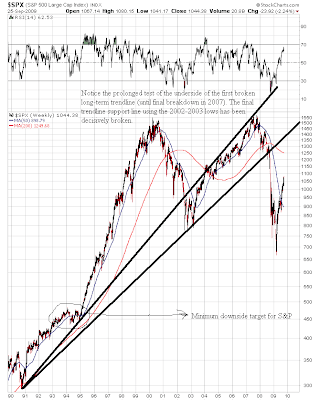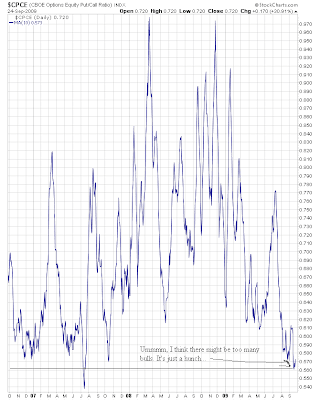src="http://pagead2.googlesyndication.com/pagead/show_ads.js">
The citizens of the United States will be paying to clean up the collapse of the real estate bubble. It doesn't matter if one participated in the housing boom or not - we are all going to pay and pay dearly for this mess. Renters, owners and speculators are all equally on the hook if they are taxpayers (did you know that
40% of people living in the U.S. pay or owe no federal income tax?).
Now it is true that those who go through a foreclosure or bankruptcy will have much stress and will take a big hit on their credit score. Those who avoided the bubble, have paid off their house in full and/or don't look at their home as an investment but rather a place to live won't have to deal with these stressors, assuming they don't become a victim of unemployment in the months ahead.
But make no mistake about it, a big chunk of the losses from the housing bubble are going to be put on the taxpayer's tab. The first round of the "bailout ball" was forced upon the unsuspecting American citizenry by Hanky Panky Paulson and his crew to "save the world" from a certain and horrible economic death. The second and third rounds will involve similar sums of money but will come from different angles.
First and most obvious is the number of bank bailouts that the FDIC, and thus the American people, will need to fund. The FDIC will
absolutely tap its new $500 billion line of credit from the U.S. Treasury. To pretend otherwise is silly and/or dishonest, as hundreds of additional banks are going to fail before this fiasco is over. In the linked article above, Sheila Bair is quoted as saying:
"Marking banking assets to market prices doesn't make sense."
No, of course it doesn't make sense. Telling the truth and doing the rational and responsible thing would immediately bankrupt our entire banking system overnight. It is much better to pretend that you haven't lost any money on any of the assets you have and instead tell people that they are still worth what you paid for them, even if their value has been reduced to zero. This is our government-banker keiretsu hard at work discouraging reality, honesty and integrity. If the head of the FDIC feels this way, there is no hope for improved transparency of bank balance sheets and no realistic way to fairly value these banking firms (Stay away! Sell!).
In the mean time, these bank "assets" are trending towards zero or less than zero (in the case of some derivative instruments and homes that have gone through
severe "trash outs"), which means that when the FDIC finally does step in, it will cost U.S. taxpayers much more than biting the bullet and bailing out these banks now. All the profits for bankers are and will remain privatized but any and all of the big losses will be put on the taxpayer's tab as much as possible. The larger banks are not stupid and have found a way to try to salvage some extra profits out of this mess (in addition to being able to stay in business) by asking their pre-bought bureaucrats to jump into the shark pool.
This is where the second of the two remaining big components of the government housing bailout comes into play. This is even more nefarious than the direct bank bailouts. It has to do with Freddie Mac, Fannie Mae, the FHA and
Ginnie Mae. These institutions are now
guaranteeing 90% of new home loans generated in this country, including the refinancing and modification of loans gone bad. Why make lots of loans in the middle of a real estate collapse? Oh yeah, I forgot - it's because all the inevitable losses will just be put on the taxpayer's tab, so who cares?
This is, in essence, a
transfer of toxic loans from private balance sheets to the government balance sheet.
Underwriting standards have been subprime and lax for these new government-sponsored loans. Private mortgage originators are going hog wild signing up anyone with a pulse who still wants to buy a house (Don't buy - rent!) if they can meet the government standards because these originators know they can turn around and pass the hot potato onto the government, making a profit/commission in the process.
In the mean time, these loans are already going bad at a alarming rate akin to subprime loans. Capital reserves are dangerously low at the government sponsored entities and rapidly declining, which means more taxpayer money will be needed down the road to bail these quasi-companies out (don't believe
articles like this where officials say they won't need extra funding - they will). The low down payments and lax lending standards required for many home loans are what helped get us into trouble in the first place and I would hazard a guess that many of the home owners partaking of these new toxic government loans are going to be close to underwater by the time the ink dries on the final loan documents.
This scheme is also why private banks are
ignoring overdue debtors for up to 2 years without finishing the foreclosure process. Not only have Sheila Bair and other apparatchik ilk encouraged private banks to avoid taking losses by allowing banks to keep home loans on the books as assets with an inflated and unrealistic value to bolster their balance sheet and make them look vaguely solvent, but the other part of the plan for banks is to stall while trying to find a way to get their toxic loans onto the books of Uncle Sam and the American taxpayer. They will find a way, believe me.
The private, non-federal, for-profit federal reserve corporation is warming up to the scam and moving things along nicely by
purchasing large amounts of commercial and residential mortgage debt. This, of course, will all be foisted onto the taxpayer tab at the opportune time. When this occurs, it will sold as "an investment," but this will be yet another cruel joke on the American people.
So, in the end, it's all coming together for many bankers. The housing and commercial real estate collapse continues unabated and the bill is increasingly going to be put on the U.S. taxpayer's tab, allowing many bankers to get off scot-free and pocket some dough in the process. This moral hazard Uncle Sam is creating ensures more risk-taking and speculation in a real estate market the government has no business encouraging people to speculate in right now. It also absolutely guarantees an even bigger disaster down the road for Uncle Sam's balance sheet. Privatizing gains and socializing losses - damn it feels good to be a banksta!
Such moral hazard also encourages debtors to just
walk away from any bad housing debts. When people aren't paying their mortgage, they rarely will make property tax payments, so this federal government interference/moral hazard and willful banker neglect of past due loans will also impact local governments tremendously. It is likely that these local governments will try to squeeze some blood out of a stone by asking those left standing who either own their homes or still pay their mortgage to pay higher property taxes. Being financially responsible increasingly means being asked to bend over and accept higher taxes and/or currency debasement while feeling "left out" of the debtor party.
Many citizens support the government "stabilizing" housing prices based on self interest. Yet such folks don't realize that government can only waste money while making things worse for the whole country and not doing anything but prolonging the pain that has to happen to allow the market to heal. Bad debts must be liquidated, not hidden or subsidized. Government cannot "stabilize" housing, but they can put lots of toxic liabilities on the taxpayer tab while the real estate market proceeds lower to the same levels it was going to go anyway.
Unfortunately, all of this government interference does mean that housing will take longer to find its true bottom - I think we're looking at 2014 or later. It also means that the government debt load is going to increase astronomically over the next few years (what's a few extra trillion, eh?), almost ensuring a serious currency dislocation at some point down the road. Be sure to watch with feigned amusement when the apparatchiks tell you in a year or two that no one saw it coming as the next bailout is announced or a currency crisis/capital flight rears its ugly head. Home sweet home, my ass. We're all going to pay for the housing mess - one way or the other.



























